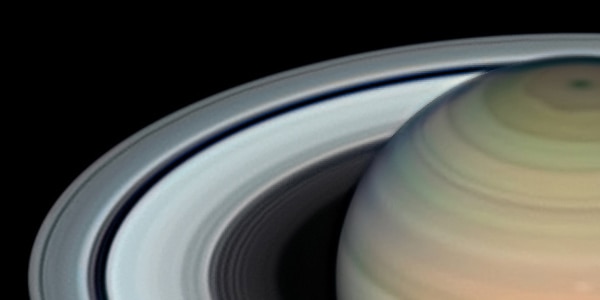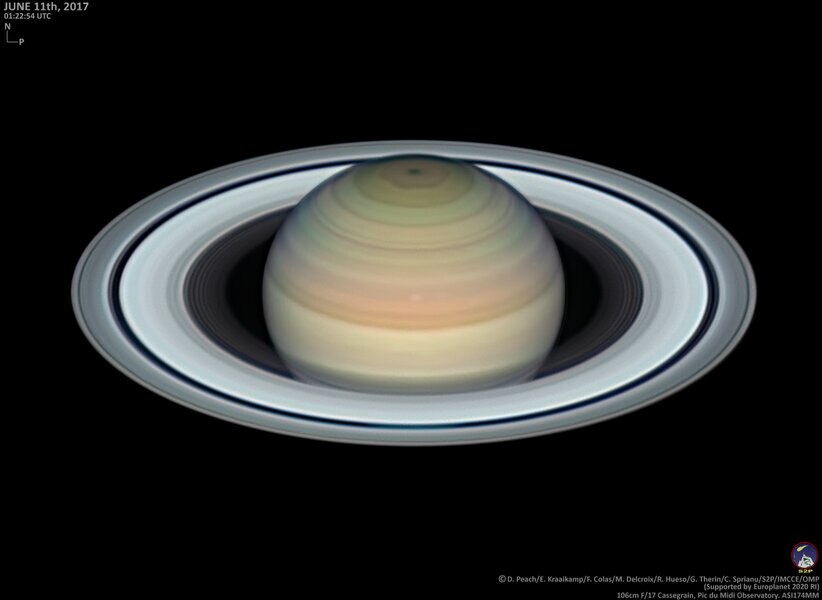Create a free profile to get unlimited access to exclusive videos, sweepstakes, and more!
Astrophoto: From Earth, Saturn!

There is never not a good time for some Saturn in your life. With a little help from a team of seven astrophotographers, I can help you. So, behold! The ringed world*!
That shot above is not from the Cassini spacecraft. It was taken on June 11, 2017, using a 105 cm (42”) telescope located at the renowned Pic du Midi Observatory, located in the French Pyrénées. It’s at an elevation of nearly 3000 meters, and has an unusually steady air flow past it. That’s important: A steady atmosphere means less twinkling, less distortion of the light from astronomical objects. That means images taken there have very high resolution, and I’ve always been very impressed with what I’ve seen coming from that location.
This image of Saturn is no exception … except it is, because even for Pic du Midi it’s incredible. It was taken by a team of seven people (see the image credit), including Damian Peach, and Emil Kraaikamp, both of whom have had their work grace my blog in the past.
Damian says this may be the best image of Saturn taken from Earth, and I have to consider that he may be right. The detail is simply phenomenal. You can see lots of banding in Saturn’s atmosphere, which is difficult to capture. The thinner bands usually tend to blur together, and the haze in the air there fuzzes them out as well. You can clearly see the weird hexagonal wind pattern surrounding the planet’s north pole, as well as the blue storm sitting right at the pole. For scale, that storm is over 2000 kilometers across. The hex is 20,000 kilometers across.
Our entire planet is less than 13,000 kilometers wide. Saturn is immense.
And the rings! Sweet merciful annuli, those rings.
The brightest ring in the center is called the B ring, and is separated from the outer A ring by the dark Cassini Division. The fainter C ring is inside B, and has all those rippling ringlets in it.
It’s amazing how many rings there are in the shot; can you count them all? And the gaps in the rings are so easy to spot as well, including the Encke Gap in the outer A ring, which is about 325 kilometers wide (the Cassini Division is nearly 5000 kilometers across, roughly the distance across the continental U.S.). By the way, Saturn is over 1.3 billion kilometers from Earth right now — that’ll give you some perspective on just how good this image is, seeing features just a few hundred kilometers across at that vast and terrible distance.
Right now, the northern hemisphere of Saturn is experiencing the height of summer, with the north pole tipped toward the Sun, so we see it more clearly. Because of that, the shadow of Saturn itself doesn’t stretch across the rings as it would in the spring or fall when the sunlight is coming more in the plane of the rings. It’s pretty cool to see the A ring all the way around, unblocked by the planet itself or its shadow.
On top of all that, Saturn is at opposition right now. That’s an astronomical term for when an object is opposite the Sun in the sky, and for the outer planets happens only about once per year, when the Earth laps them in its own orbit. Think of two cars going around a racetrack, with the car in the inner track moving much more quickly. If you are standing in the center, you’ll see it lap the outer car, then go all the way around the track, then lap it again, but it takes a bit longer because the outer car is moving as well, and it has to catch up.
There are lots of bonuses with viewing a planet at opposition. For one thing, it’s as close to Earth as it gets all year. For another, it’s at its brightest, too, because it’s closer. Also, because it’s opposite the Sun in our sky, it rises when the Sun sets and sets when the Sun rises: In other words, it’s up all night.
If you have binoculars or a telescope, now’s the best time to look at Saturn (well, anytime in the next month or two is best, really, and it’s still easy to see for the next few months after that). If you don’t, then find out if there’s an observatory near you that holds a public night, or seek out your local astronomy club/society. I’ve never met an astronomer who doesn’t delight in watching someone else see Saturn through a telescope for the first time. It’s magical. Grab this chance.
* Yes, I know, Jupiter, Uranus, and Neptune have rings as well. But c’mon. There’s pedantry, and then there’s Saturn.
[Header/hero image credit: D. Peach, E. Kraaikamp, F. Colas, M. Delacroix, R. Hueso, G. Therin, C. Sprianu, S2P / IMCCE / OMP]



























